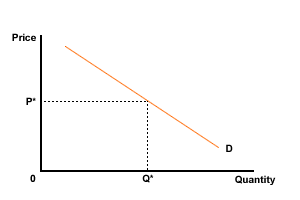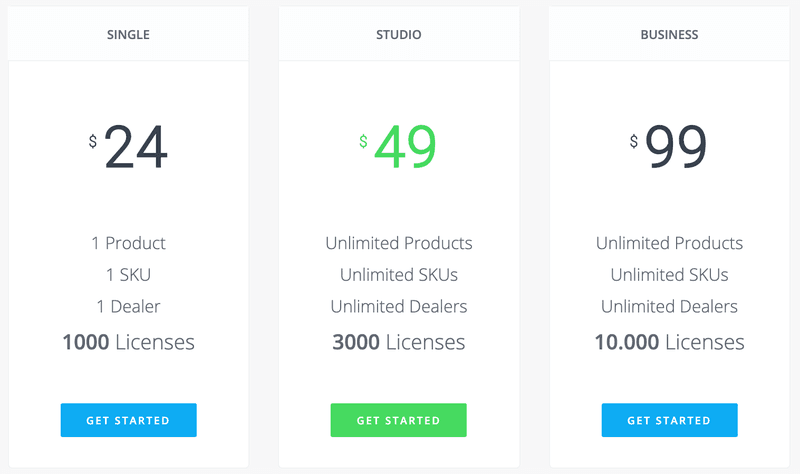Independent software vendors (ISVs) often spend so much time thinking about engineering the product that they completely neglect the marketing and sales facet of the launch. In the early stages of growth, most especially, software pricing is one of the most critical aspects of any tech start-up.
So we gathered 7 things for you that any software vendor must know about software pricing for the long-term success of their digital products:
#1: Set Your Price By Being Different

"When a new version comes out with new features, we see a sudden, undeniable, substantial, and permanent increase in revenue.” – Joel Spolsky, Software Developer
Blue Ocean strategy is all about finding your Points of Difference (P.O.D) and leverage that. All successful software brands have been doing so. They create their own niche markets by innovating, rather than focusing solely on their competition and missing the whole point. When it comes to software pricing, the same applies. By being different and unique, "you" get to control the pricing of your software products. Otherwise, the market does it for you, when you remain to be one of the ordinary players within the market.
Moreover, according to research done by Yale, similarity leads to action paralysis, prompting customers to lean to more differentiated options. Meaning that too many similar options within the market will lead away the customers either to cheaper options or to products offering bonus features. Identify at what niche your software products could thrive, research and develop accordingly, do marketing differently, and then you get to have control over your pricing, independently.
#2: Perceived vs. Real Value

Economics theory suggests that to maximize profits, you need to find the right equilibrium in which the largest rectangle on ( sales × price) represents the highest revenue.

When it comes to software pricing, however, economic theory is irrelevant. For one reason, supply and demand curves are based upon the assumption that producing additional products comes with a certain amount of cost. Which is not the case for the software industry, since the cost of an additional copy of a software product is almost zero. Another reason is that the demand for software products is hard to estimate considering the transitivity of the digital markets.
Good news is that the perceived value of your product has nothing to with "Economics 101" or even the real value of your software product per se. Because customers need to perceive the value before making the actual purchase, determining the demand for your product, and so the price. In other words, as the objective (or real) value of a product is what the product is actually worth without any outside expectations from the consumer or seller, perceived value is customers' evaluation of what the product worths to them.
As we touch upon later on this post, you can even set a higher price for your product without altering your software only by enhancing the potential perception of customers over your product.
Customer Perceived Value
Options are limitless to increase customer perceived value (CPV). One of the best ways is to have a better visual design. No wonder why Apple charges premium. Apple out-designs its competition any day of the week. Along with the visual design, a better user experience (UX) on your website is definitely a factor to enhance the perception of your brand. Or you can simply establish yourself as an industry thought-leader through the valuable content you gather for your consumers. For which blogs will surely help. If you want to learn more about increasing CPV, make sure you checked up on our latest post on brand enhancement strategies for small software businesses.
#3: Avoid Competitive Pricing

Sure, one needs to keep a watchful eye on the markets, how the competition is doing so on and so forth. But for small business competing on price, as Seth Gordan puts it, is the race to the bottom. Unless you have an established brand or a considerable cost advantage over your competition, that’s better not to even go down this path.
For one reason, it gets you distracted from other tasks that more prominently affect your brand image. And lower prices do not necessarily result in higher sales. That is all about customer perception and how much value you can bring to the table. As mentioned earlier, you need to distinguish your brand with your product offering, not your pricing. That leads us to the differences between value-based pricing and cost-based pricing models:
Cost-Based Pricing
Cost-based software pricing strategies are focused on short-term winnings to the independent software vendors. It enables the vendor to adjust prices in accordance with competition by offering competitive prices to lure customers away from competitors. This model, however, that ignores customer-value requirements, can no longer ensure a favorable rate of ROI to the software vendor as software markets have become more saturated and buyers are faced with more choices.
Value-Based Pricing
Value-based software pricing strategies, on the other hand, are focused on creating long-term value for the customer. It based upon the CPV of the benefits received. As the aim of the value-based approach is to enable more lucrative pricing by capturing more value, software businesses must focus on design and deliver customer-centric marketing strategies that more accurately reflect the value that consumers expect and are willing to pay for.
#4: Tiered Pricing
Customers are already familiar with tiered pricing models and they expect them. From a psychological point of view, you get to provide your users with a reference point by setting up tiered prices for your software product. Otherwise, they will surely check the prices of your competition, and possibly enter their funnels.
One certain advantage of tiered pricing is that you can actually increase the "perceived value" of your product through premium packages.
Premium Pricing
Premium price point, also called "prestige pricing”, promotes exclusivity. The premiums hand you three golden opportunities giving you the edge over your competitors. First, by pricing above the competition, you base your brand image around the perception of high-quality. You promise full value for money of your prospects, as you must deliver. That eventually increases the perceived value of your software product. Second, you’re giving an option for customers willing to pay more for the exclusive features. And third, you get to make the regular price seem like a pretty good deal, as it is!

Take a look at our premium pricing options at KEYZY in which we offer business-class packages up to 10.000 licenses. It does not only bring to the fore the massive value you can have with the Studio Package, but also helps us reach out to the customers looking for more extensive options.
Freemium Pricing
Another way to leverage tiered pricing is taking the freemium approach, which means to start off with a free price tier. "Free" is a powerful concept. Customers LOVE free. And that's always a good idea to let customers try before they buy. That does not necessarily have to happen through free-trials though. Freemium packages allow the user to try out a limited version of your software, just for the taste of it. Give away a low-end or lite version of your digital product for free so that the user familiarize with your software piece without having to go through the tedious buying decision process.
The current best strategy for software is to license it. And this model only works if you have the means to license your software, once the user is ready for purchase in need of more storage/bandwidth/capacity/capability. As a free version of your digital product will help you attract more users, you definitely need reliable and hassle-free licensing solutions to sustain such a funnel.
This is where KEYZY steps in for you. Only with a license key you distribute to the user, you can determine the usage period of your software pursuant to the subscription plan.
KEYZY saves you time and energy by painlessly managing your licenses. So that you focus more on what matters: your customers.
#5: Bundling

Software bundling is the practice of selling a set of single software programs in a single package.
Products are bundled together and sold at a lower price than if purchased individually. By doing so, ISVs get to increase their sales for the massive value it offers for the user. All components of the bundle are typically activated with the same license key. There are two types of bundling:
Price Bundling
That is simply providing a discount to the buyer buying two or more software programs at the same time. Often used for its promotional value.
Product Bundling
Product Bundling, on the other hand, is to create added value for the buyer than the individual products itself. Microsoft Office is a good example of software product bundling, with individual programs like Excel, Word, and PowerPoint, presenting tremendous value for the user as a whole.
KEYZY assists software businesses with their bundling efforts as well. You can combine your products as you wish and then distribute/deposit just one license to the customer. This way, the user could use one serial number for each product in the bundle and that would be it! That’s simply how hard it is to manage your bundles with KEYZY.
#6: Leverage Human Psychology
Economists use the financial term of "Homo Economicus” to describe a rational human being. However, modeling human behavior, modern behavioral economists demonstrates that human beings are, in fact, not that rational in their decision making, making somewhat predictable irrational decisions. Let’s go through a number of pricing tips leveraging behavioral decision-making.
Psychological Pricing

The psychological pricing is based upon buyer purchasing behavior, how they respond to certain price points. For instance, by setting prices just below a whole number, like 7 or 9, ISVs get to increase their sales considerably. This pricing strategy is also called "charm pricing". A classical example of charm pricing is an experiment conducted by MIT with prices on women’s clothing. They presented three basic prices, $34, $39, and $44. Surprisingly, the item sold best at $39, outperforming even the lowest price of $34 on average by over 24 percent. I.e., unless you pursue a prestige pricing strategy, instead of pricing your software at $30, $50, and $100, consider pricing at $29, $49, and $99 respectively to stimulate sales.
Utilize Price Anchoring
Price anchoring helps vendors establish a price point that the user can refer to when making a decision. When you see a discount with “$110 $89”, the $110 is the price anchor for the $89 sales price.
In an often-cited study, a number of real estate experts were put to the test, anchored by low and high list prices for the houses that they were supposed to evaluate. The anchoring effect was so powerful that even the experts were not immune to it, ending up every time presenting estimates influenced by the list price.
Price anchoring, most importantly, enables you to funnel your customers to your ideal, mid-range packages. By tiering prices accordingly, placing in between premium option (high price anchor) and entry-level option (low price anchor), you get to set off the value that the prospect can get for the standard option.
Keep It Simple
Another psychological study conducted on pricing suggests that, when this pricing structure was shown to the subjects (— $1,599.00 — $1,599 —$1599), first two prices seemed far higher than the unpunctuated third version, because of the additional syllabic length of the comma and cents. That’s why you must avoid all unnecessary additions and put in a sincere effort to keep your pricing structure as simple as possible.
#7: Take an Educated Guess and then Optimize

There are no absolute truths or precise formulas for finding the right prices for your product. As you have seen by now, many divergent factors are determining the price of a software product. What you can do, however, is to start with an educated guess and then optimize accordingly.
Right software pricing is a synergic combination of the objective value and perceived value of your software product along with the message that you’d like to convey through the price. Let’s walk through such factors that you need to take into consideration when making the initial guess:
Your Message
A software priced at $19.99 simply displays a very different message than one priced at an $89.99. You indeed convey a message through pricing. That is why consumers pay a premium when buying a brand-name product, since the perceived value is higher, although the real value is the same. Don’t lower your price early on the launch stage just because you want to increase sales. You may mistakenly convey the wrong message to your prospects, which deviates the whole purpose in the first place.
Determining the Objective Value
As mentioned earlier, objective value is how much a consumer would pay as a “Homo Economicus” — a complete rational decision-making being. For software, the calculation of real value can be relatively simpler:
(Hourly Rate of Developer × Development Time in Hours) — Price = Value
However, especially in the pre-launch stage, objective value is something only a developer can truly understand. That is up to sales and marketing to convey this value on the later stages of your launch to the consumer, who eventually determines the perceived value of your software.
Understanding The Product's Perceived Value
Customers are buying the whole brand experience when making the purchase, not just the end-product. And that leads us to understanding the perceived value of a software product.
Who is your persona? How your software programs solve the problems of your consumers? Who’s making the purchasing decision? Or, how is the UX on your website? How well designed your product compared to your competition? How accessible is your software product in the market?
This is all a question of perceived value. That is something software vendors can never really determine early on. However, with the right amount of insight and research, you get to pretty accurately estimate the perceived value of your product. Once you do so, taking that as your reference point, start to optimize by testing several prices along the way to approximate the ideal price of your product.
Remember that there is no such thing as the “best price”. Your price is only good to the extent it reflects the customer's perceived value. Work through your value proposition, what sets you apart from your competition, and the overall marketing message you’re getting across to your consumers. All in all, the more value you bring to the table, the more lucratively you get to price your software products.
How is your experience with software pricing so far? We would love to hear about it and any questions you have in the comments!